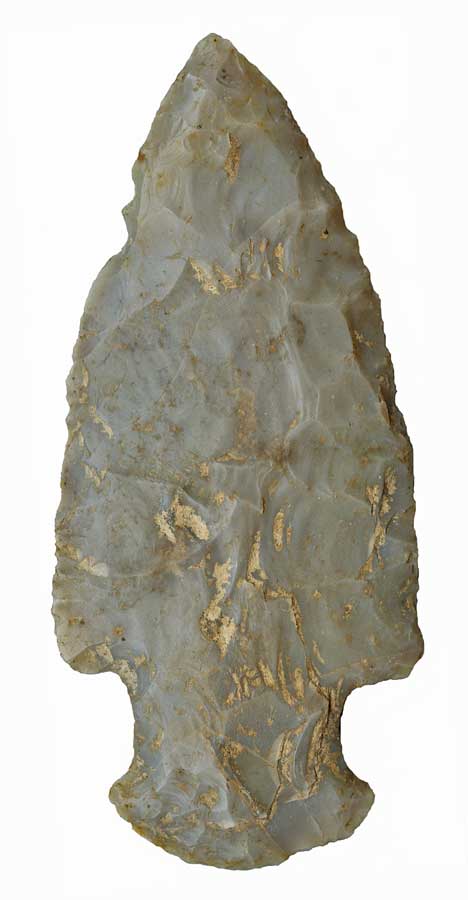

Point Type: HOPEWELL - SNYDERS
Also See: Affinis Snyders, Bay de Noc
Side Notched, Big Creek, Buck Creek
Barbed , Burnt Bluff, Gibson, Grand
, Hamilton Stemmed, Lowe Flair Base,
Manker Corner Notched, Motley, North, Norton Corner Notched, Ross, Snyders
Location: Midwestern to Eastern United States
Associated Dates:
2150 - 1700 B.P. - Woodland
Morphology: Corner
Notched
General Description: The Hopewell-Snyders
type is a medium to large sized, broad and thick point with corner notches
and excurvate blade. The excurvate blade terminates in prominent barbs
in many specimens. The stem is short in relation to the overall length of the
point and is expanding. The base expands and is almost always convex or
excurvate in outline. The corner notches are wide to the point of almost being
considered side notches and the notches are well rounded. Grinding of the
stem is not present.
Most specimens from western Indiana and Illinois are
made of Burlington flint which was heavily utilized by the Woodland peoples of
the region. Many of the points found in southern Indiana to western
Ohio are made from Harrison County, Indiana, gray flint. Upper Mercer
and Flint Ridge flints were occasionally used in Ohio. Additionally, other
locally available white and tan cherts were also used.
This is a
confused projectile point type in so far as the Affinis Snyders and the
Snyders types are very similar to this type. The Hopewell -
Snyders has really never be named as its own type by the archaeolgical
community. Some Lowe Flare Base points also look similar and may be
chronological decendents of this type. Other similar types include the
Gibson, Northon Corner Notched, Bay de Noc Side Notched, Burnt Bluff
Expanded Stemmed and the Ross point.
The Mund site in Illinois yeilded
dates of 120 to 120 years BC and this dates the classic Hopewell sequence
very well (Fortier, 1983:395).
Many examples of this type,
found in Illinois and Missouri exhibit heavy use wear as scrapers and many have
been halfted into scrapers. It is belived that most started life as
knife blades and were turned to the roll of scrapers as rework reduced the
tool.
The Hopewell - Snyders point type is found all over Indiana,
the Wabash River drainage area in Ohio as well as
Illinois.
The size of the Hopewell - Snyders point can range from 42 mm to 200 mm in length
with the typical point being in the 57 mm range. The average width of the blade
is between 31 mm and 52 mm with the average being 40 mm. The average stem
width is 27 mm and an average stem length of 15 mm.
The
Hopewell - Snyders point type was described by Edward G. Scully in 1951 for
the Snyders Hopewell site in Calhoun County, Illinois.
About The Point Above: The very large sized Hopewell - Snyders blade pictured at the top of this page, was found in Wapakoneta County, Ohio and is made from a satin light gray Flint Ridge chert. The blade is 110 mm long, 47 mm wide, stem width at the neck is 26 mm and basal width expands to 34 mm. The stem length is 26 mm. Thickness is 9.9 mm at the neck of the stem but the blade is 8 mm over most of the blade. The point is heavily patinated and encusted with mineral deposits of some sort, and there is still some dirt in a few of the knapping scars Some of the knapping ridges are smoothed either to use wear or erosion. The left hand upper edge of the blade has two dings which appear to be modern. There is no basal grinding on the stem. This artifact was formerly in the Will Burchett collection and has a Jeff Baker certificate of authenticity No. 6457. Catalog Number 359-190-HH
References: Bell (1), Converse, DeRegnaucourt, Dragoo (f), Fogleman, Heranicky, Justice, Overstreet, Waldorf
© Copyright 1997 - 2009 LITHICS-Net WWW.LITHICSNET.COM
Use your Browser's BACK Button to return to the LITHICS-Net Index.